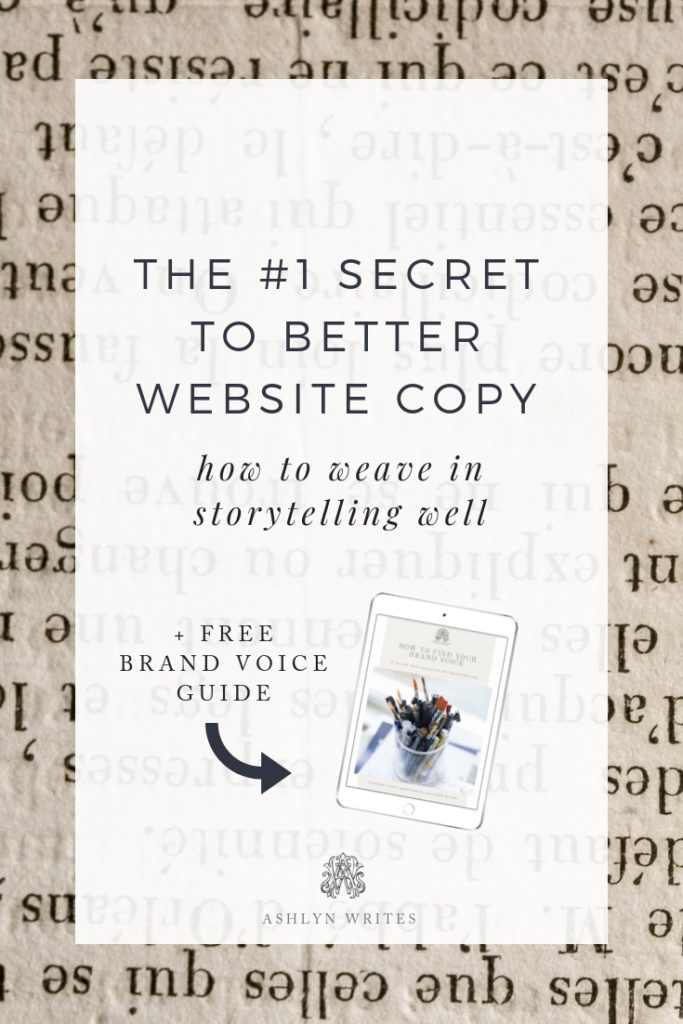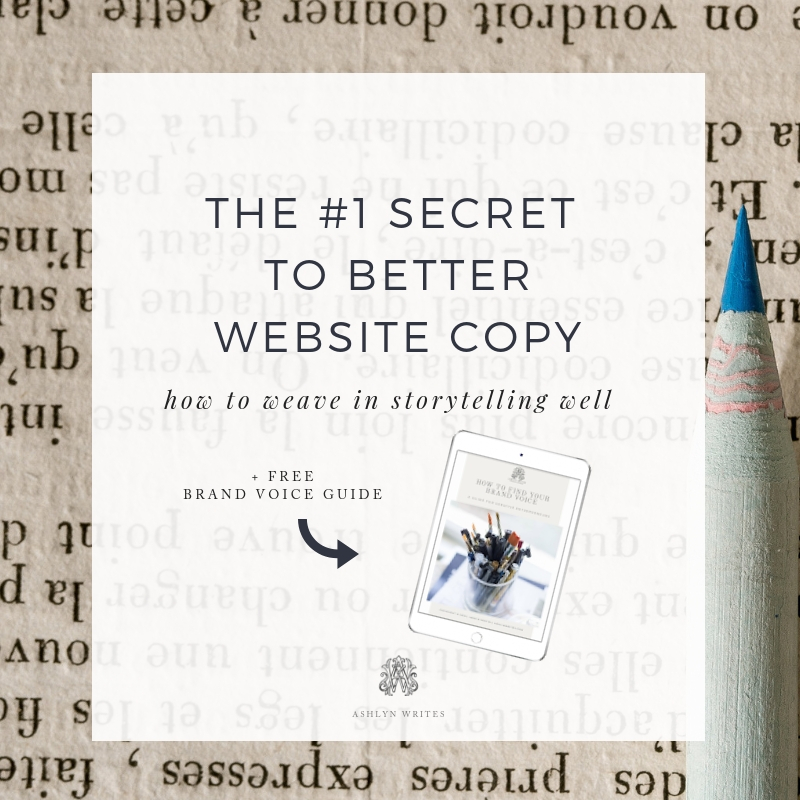“Almost all good writing begins with terrible first efforts,” Anne Lamont declares in Bird by Bird.
[bctt tweet=”“Almost all good writing begins with terrible first efforts.” -Anne Lamont” username=”via AshlynSCarter”]
When composing your website copy feels more akin to hacking away at keys than blissful copywriting, that sure is a helpful line to remember.
That, and the real secret to better website copy.
The secret? Non-visual storytelling matters.
Today, I’m going to teach you about creating your brand story—a GREAT way to DIY compelling copy that doesn’t sound tacky.

Strong imagery for our brands matters greatly for our creative small businesses—pristine, charming little squares on our feed are like magazine pages of which we each are our own elected editor-in-chief, and those images are an important part of brand storytelling!
But I want to argue the reasons why words still matter in our visual world.
Words hold hefty weight simply because story still matters, and while visuals can communicate much of this, they don’t communicate all of it.
Design piques interest, but copy converts.
Let’s talk about what storytelling on your website is, why you need it, and how to do it! You’ll learn:
- What does “story” have to do with your website copy—and the 3 you need to have
- Where these elements can go on your website
- 5 ways to start telling a story (visually AND non-visually) on your website
Let’s go! And as we work through this, don’t forget that your brand stories need to be shared in YOUR brand voice—this is how you get on track to standing out in a saturated market. Haven’t figured that out before? No worries! ???????? Grab my FREE guide to figuring out your brand voice right here.
What I Mean By “Storytelling”
Storytelling is a few thousand-year-old communications “best practice.” Storytelling is central to human existence—”anthropologists tell us that storytelling is central to human existence,” according to Wired magazine.
It is so woven into the fibers of our humanity that the practice traces to our species, predating farming and agricultural practice. In fact, storytelling is so innate, that you likely spend 50% of your day daydreaming according to a story released by Harvard (not counting pillow-rested, silk eye-mask dreams!).
It makes sense that statistically, a mind viewing a film or catching up on Netflix rarely daydreams: the screen is telling the story for you, so you’re already caught in story.
Make sense?
We use stories to make sense of the world and to share that understanding with others.
So, what does this mean for us as business owners?
As you market your creative small business, whenever you want something to stick, try story, anecdote, or analogy.
It just works.
Just think about how our brains hang on to old jokes, movie plots, favorite books, and more. I don’t know about you, but I can remember dumb urban legends we’d talk about at sleepovers for years!
Let’s talk about the 3 essential stories you need to have in your business.

How to Tell a Story in Your Business: The 3 Essential Stories You Need
American scholar Joseph Campbell’s 1949 book, The Hero With A Thousand Faces, is a pattern of narrative that shaped a lot of screenwriter and director’s thoughts about story—according to Entrepreneur magazine, George Lucas has said it influenced Star Wars. I personally think Campbell was a fruit loop about some things, but identifying a hero’s journey is one thing he nailed.
In a nutshell, the hero’s journey describes the typical adventure of a hero archetype on their way to achieving greatness (If this hooks you, listen in to Donald Miller’s StoryBrand podcast—he does a great job explaining it!).
The way that correlates to marketing your art?
Storytelling looks a lot less like you being the hero than it does your client being the hero—and you coming in as the guide to assist on her path to greatness.
On your website, you’re not just communicating YOUR story, but you’re communicating to a bride how your planning, calligraphy, or photography services will enhance her wedding day story.
Or, you’re a creative attorney expressing how you can help your client dream up a business story bigger than she has ever dreamed before, given the right licensing tools.
Or you’re a graphic designer showcasing that the right typestyle and palate can propel your client into attracting her ideal client.
Here’s an infographic that explains it briefly:

Simply put, when I work with clients, we try to identify 3 brand stories that they need to have back-pocketed as they market their business.
The 3 stories I believe you need to have figured out and able to communicate as a creative small business are:
- Your origin story, how it is that you started doing what you do
- Your a-ha moment, how you saw a need and realized you could fill it
- A testimonial or transformation story that your client can see themselves in
We as humans love story, and …
It’s woven in us to gravitate toward storytelling. Our brains are wired to connect soul to soul when there’s a tale woven in the mix.
So now, let’s talk about some practical ways you can create a brand story!
4 Quick Tips to Tell a Story on Your Website
Storytelling can exist in your home page, newsletters, about page, services, contact page, blog posts, Instagram captions, client email templates, pricing guide, and more.
Just remember that social media will always be changing, so your website is where the bulk of your story and messaging should live.
Here are five takeaway homework tips for you to tackle:
Tip 1:
Recognize that like it or not, your brand’s story is already out there (“A brand is no longer what we tell the consumer it is – it is what consumers tell each other it is,” Scott Cook says.) — lean into the conversation and meet fans of your small business where they are.

Tip 2:
Carve out time to identify those 3 stories I mentioned above! As you do this, really work to understand your ideal client, and speak to him or her. Have that ideal client mapped out to a “T” and target her external, internal, and psychological problem. For example, if I were writing copy as a wedding photographer, I’m writing to solve these problems:
- Suzy (external) needs her wedding documented
- Suzy (internal) wants someone her fiance and wedding party are comfortable enough around to be themselves, so the pics look authentic and awesome, and …
- Suzy (psychological) tends to get insecure about having herself photographed, and wants to feel beautiful when she looks back on these memories.
Tip 3:
Work in story on your “work with me” page. This is one thing I spend a lot of time with my students on. Powerful story triggers an action or investment. Write to show two things on your sales page: empathy and authority. Then, give a specific plan. Threes are good. “We’ll do Step 1, Step 2, and then you’ll be so happy with Step 3 results.”
Tip 4:
As you figure out these stories, simplify them. Clarity attracts, confusion doesn’t. There’s a saying in copywriting: aim for clarity over cleverness. Smart, sharp writing matters because there are so few solid, tight writers on the internet. You’ll stand out. A good writer knows when to “kill her darlings,” and edit something out.
Story is a BIG chunk of brand messaging, and we’ve just dusted the surface here, but I sure hope this helps you get started.
Another part of communicating your story? Your brand voice. If you’ve not spent some time penning that on paper, I’ve got ya: download my FREE guide to finding your brand voice, and get started knocking out this part of your messaging as you DIY your own copy. ????????
Reading Time: 6 Minutes Reading time: 5 min. “Almost all good writing begins with terrible first efforts,” Anne Lamont declares in Bird by Bird. [bctt tweet=”“Almost all good writing begins with terrible first efforts.” -Anne Lamont” username=”via AshlynSCarter”] When composing your website copy feels more akin to hacking away at keys than blissful copywriting, that sure is a helpful […]




[…] The #1 Secret to Better Website Copy: How to Weave in Storytelling Well […]
To answer your question, one of the narratives I love is from the movie About Time with Domhall Gleeson and Rachel McAdams. If you haven’t seen it, you’ll really enjoy it. The message that stuck with me for a long time after is that it’s important to enjoy the little moments in life because those are what creates a happy life. If you spend time angry or stressed, especially about things outside the present, that is what your life will be filled with. So basically live in the present and embrace every moment you have as if it was your last. Then you will be more likely to make the most out of every single moment and live a life of value and purpose. Rather than yelling at your child for making a mess, laugh and wallow in that mess with her. Rather than rushing to your next appointment, look at your surroundings as you get there and contemplate their beauty. You’ll enjoy life way more.
I love this, Yasmin! It’s a great reminder as we all go about our business in an often-hurried life. I DO love that movie, too! xx.Ash